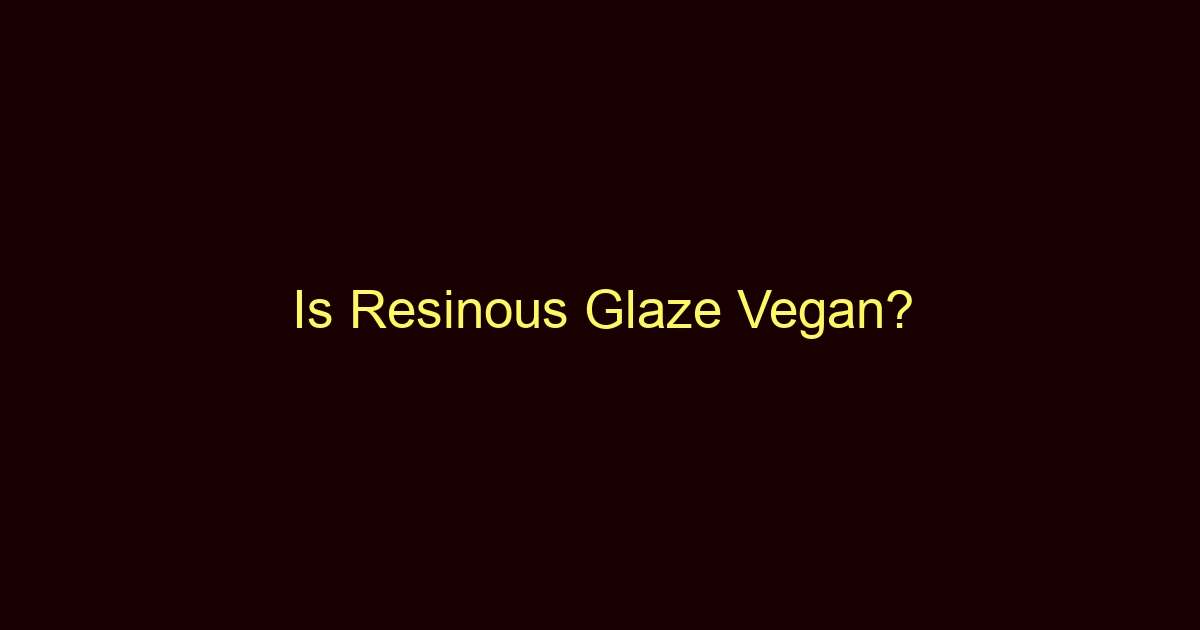When it comes to determining if a food product is suitable for vegans, understanding the ingredients is key. One such ingredient, which may not be familiar to many, is “resinous glaze”. But what is it? Is it derived from animals, plants, or synthesized in a lab? Most importantly for vegans, is it suitable for consumption according to the principles of their diet? Let’s find out.
What is Resinous Glaze?
Resinous glaze, also known as shellac, is a substance secreted by the female lac bug on trees found in the forests of India and Thailand. It’s harvested by scraping the bark of the trees and then refining it into flakes, which can be dissolved in alcohol to make liquid shellac. Interestingly, it has been used for centuries, not just in food, but also in furniture polish, varnish, and even in the cosmetic industry.
The use of resinous glaze in food products might seem peculiar, but it plays a critical role in maintaining quality and appearance. It’s known for providing a high-gloss, protective finish that can significantly enhance the aesthetic appeal of certain foods. But that’s not all; let’s delve further into its composition.
What is Resinous Glaze made of?
As previously mentioned, resinous glaze is derived from the secretions of the female lac bug. These insects feast on the sap of specific trees and excrete “lac resin” on the branches. This lac resin is the key ingredient in resinous glaze. It’s important to note that while the resinous glaze itself isn’t composed of bugs, it is a direct product of their lifecycle and involves the potential loss of insect life during its collection.
This notion raises questions about the compatibility of resinous glaze with different dietary preferences, especially veganism. To further understand this, let’s examine what foods commonly contain this ingredient.
What Resinous Glaze is used for?
Resinous glaze is primarily used as a coating or glaze on certain food products. It’s particularly common in confectionery, where it lends a glossy shine to sweets like jelly beans, candies, and chocolate-covered nuts and raisins. The shiny appearance of these products can often be attributed to the application of resinous glaze.
What Foods Contain Resinous Glaze?
As mentioned, resinous glaze is commonly found in confectionery. If you’ve ever wondered why certain candies are so shiny, the answer is often resinous glaze. Moreover, it can also be found in certain fruit coatings and pharmaceutical products, where it’s used to give a glossy appearance or to make tablets easier to swallow.
Is Resinous Glaze Vegan?
Technically, resinous glaze is not vegan. Since it’s an animal-derived product (in this case, an insect), it doesn’t meet the criteria of a vegan diet, which excludes all forms of exploitation of, and cruelty to, animals for food, clothing or any other purpose. This includes substances derived from insects.
Despite being a naturally occurring product, the collection process of resinous glaze may cause harm or death to the lac bugs. Therefore, many vegans choose to avoid it, though opinions can vary. Some vegans may feel the impact on insects is minimal compared to the larger issues of animal farming.
Can Vegans Eat Resinous Glaze and Why?
Vegans typically avoid consuming products with resinous glaze due to its animal origin. The vegan philosophy, which advocates for the rights of all animals, including insects, generally considers resinous glaze as a non-vegan ingredient. Nevertheless, it’s a personal choice, and some vegans might be less strict about ingredients derived from insects compared to those from mammals or birds.
Is Resinous Glaze Healthy?
The consumption of resinous glaze in food products is generally considered safe by most food safety authorities, including the FDA. It is non-toxic and has a long history of use in foods. However, like any ingredient, it can cause allergic reactions in some individuals. These cases are rare, but anyone known to have an allergy should avoid products containing it.
How is Resinous Glaze Produced?
As mentioned earlier, the production of resinous glaze involves the collection of lac resin secreted by the female lac bug. These insects secrete the resin on the branches of host trees, which is later scraped off, often along with the bugs themselves. This resin is then processed and purified to produce shellac flakes, which can be dissolved in alcohol to produce the final product used in various industries.
Is Resinous Glaze Ethical?
The ethics of using resinous glaze can be a matter of perspective. From a vegan point of view, because it involves potential harm or death to the lac bugs, it could be considered unethical. However, others might view it as a natural and sustainable resource, particularly since the lac bug is not a species at risk. It’s worth noting that there are plant-based alternatives available that provide similar glossy finishes to food products.
Is Resinous Glaze Safe?
Resinous glaze is generally recognized as safe by food safety authorities. It’s been used in food and other industries for many years without widespread reports of adverse effects. However, it’s always essential to consider individual dietary needs and potential allergies. For those who prefer to avoid animal or insect-derived products, there are other options available, including zein (a type of protein from corn) and carnauba wax, derived from a Brazilian palm tree.
Final Thoughts
Resinous glaze, or shellac, is an intriguing substance with a wide range of applications. While its use in food products can make certain items more appealing, it poses a dilemma for vegans and those seeking to avoid animal-derived ingredients. Although generally considered safe for consumption, its sourcing from the lac bug raises ethical and dietary considerations that each individual must weigh for themselves. Whether to consume products containing resinous glaze is a personal decision, heavily influenced by one’s dietary preferences and ethical views.

